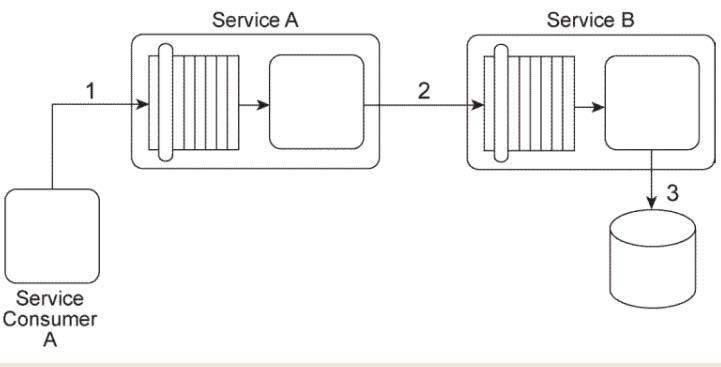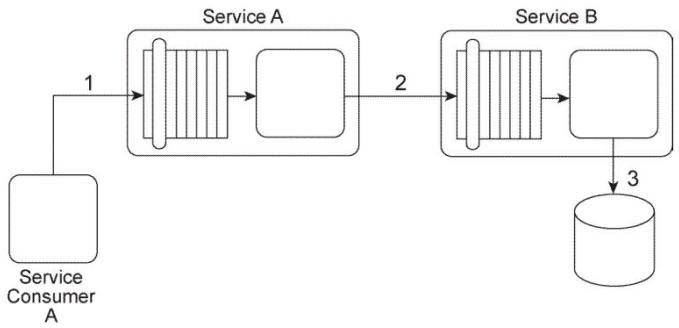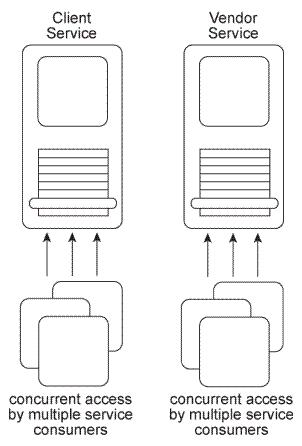

Service A is an entity service with a functional context dedicated to invoice-related processing. Service B is a utility service that provides generic data access to a database.
In this service composition architecture, Service Consumer A sends a SOAP message containing an invoice XML document to Service A(1). Service A then sends the invoice XML document to Service B (2), which then writes the invoice document to a database.
The data model used by Service Consumer A to represent the invoice document is based on XML Schema A. The service contract of Service A is designed to accept invoice documents based on XML Schema B. The service contract for Service B is designed to accept invoice documents based on XML Schema A. The database to which Service B needs to write the invoice record only accepts entire business documents in Comma Separated Value (CSV) format.
Due to the incompatibility of the XML schemas used by the services, the sending of the invoice document from Service Consumer A through to Service B cannot be accomplished using the services as they currently exist. Assuming that the Contract Centralization pattern is being applied and that the Logic Centralization is not being applied, what steps can be taken to enable the sending of the invoice document from Service Consumer A to the database without adding logic that will increase the runtime performance requirements of the service composition?
Correct Answer:
B
🗳️
Service A is an entity service with a functional context dedicated to invoice-related processing. Service B is a utility service that provides generic data access to a database.
In this service composition architecture, Service Consumer A sends a SOAP message containing an invoice XML document to Service A(1). Service A then sends the invoice XML document to Service B (2), which then writes the invoice document to a database.
The data model used by Service Consumer A to represent the invoice document is based on XML Schema A. The service contract of Service A is designed to accept invoice documents based on XML Schema B. The service contract for Service B is designed to accept invoice documents based on XML Schema A. The database to which Service B needs to write the invoice record only accepts entire business documents in Comma Separated Value (CSV) format.
Due to the incompatibility of XML schemas used by the services, the sending of the invoice document from Service Consumer A through to Service B cannot be accomplished using the services as they currently exist. Assuming that the Contract Centralization and Logic Centralization patterns are being applied, what steps can be taken to enable the sending of the invoice document from Service Consumer A to the database without adding logic that will increase the runtime performance of the service composition?
Correct Answer:
C
🗳️
The Client and Vendor services are agnostic services that are both currently part of multiple service compositions. As a result, these services are sometimes subjected to concurrent access by multiple service consumers.
The Client service is an entity service that primarily provides data access logic to a client database but also provides some calculation logic associated with determining a client's credit rating. The Vendor service is also an entity service that provides some data access logic but can also generate various dynamic reports.
After reviewing historical statistics about the runtime activity of the two services, it was discovered that the majority of concurrent runtime access is related to the processing of business rules. With the Client service, it is the calculation logic that is frequently required and with the Vendor service it is the dynamic reporting logic that needs to be accessed separately from the actual report generation.
Currently, due to the increasing amount of concurrent access by service consumers, the runtime performance of both the Client and Vendor services has worsened and has therefore reduced their effectiveness as service composition members. What steps can be taken to solve this problem without introducing new services?
Correct Answer:
B
🗳️
Currently, due to the increasing amount of concurrent access by service consumers, the runtime performance of both the Client and Vendor services has worsened and has therefore reduced their effectiveness as service composition members. Additionally, a review of the logic of both services has revealed that some of the business rules used by the Client and Vendor services are actually the same. What steps can be taken to improve performance and reduce redundant business rule logic?
Correct Answer:
A
🗳️